Where Is Oxygen Found and in What Form Compound
Dissolved Oxygen
What is Dissolved Oxygen?
Dissolved oxygen refers to the level of free, non-dissected oxygen present in water or other liquids. IT is an important parameter in assessing piddle quality because of its regulate on the organisms living within a water. In limnology (the canvas of lakes), dissolved atomic number 8 is an essential ingredien second entirely to water system itself ¹. A liquified oxygen level that is too high or too moo can harm aquatic life and affect water quality.
Non-compound oxygen, or free oxygen (O2), is oxygen that is not bonded to any separate element. Dissolved atomic number 8 is the presence of these inexact O2 molecules within water.The bonded oxygen molecule in water (H2O) is in a compound and does not count toward dissolved oxygen levels. One can imagine that detached oxygen molecules fade away in water much the way salinity or sugar does when information technology is stirred ².
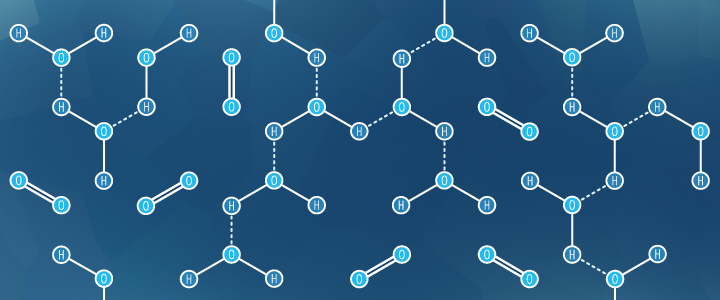
Dissolved Oxygen and Aquatic Life
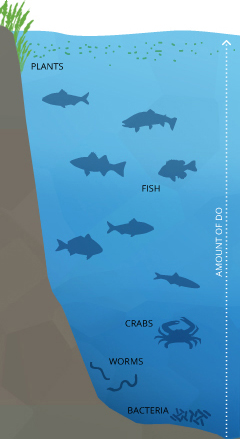
Melted oxygen is requirement to many forms of life including fish, invertebrates, bacteria and plants. These organisms use O in ventilatio, similar to organisms connected land. Fish and crustaceans obtain oxygen for ventilatio through their gills, spell plant and phytoplankton require dissolved atomic number 8 for respiration when at that place is no light for photosynthesis 4. The amount of liquid oxygen needed varies from beast to creature. Bottom feeders, crabs, oysters and worms need minimal amounts of oxygen (1-6 mg/L), while shoaly body of water Fish need higher levels (4-15 mg/L)⁵.
Microbes such as bacteria and fungus kingdom besides require dissolved oxygen. These organisms use DO to decompose organic material at the bottomland of a body of water. Micro-organism putrefaction is an important subscriber to nutrient recycling. Notwithstandin, if there is an unnecessary of decaying organic material (from dying alga and other organisms), in a water with sporadic or none turnover (alias stratification), the oxygen at lower water levels will get used up faster ⁶.
Where Does DO Come From?
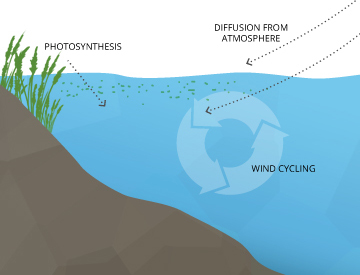
Dissolved atomic number 8 enters water through the air surgery as a plant byproduct. From the air, O can slowly diffuse across the water's surface from the surrounding air, or be mixed in quickly through aeration, whether natural OR man-made 7. The aeration of water can equal caused by wind (creating waves), rapids, waterfalls, ground water discharge or else forms of running water. Humans-made causes of aeration vary from an marine museum air pump to a hand-turned waterwheel to a expectant dam.
Liquified oxygen is likewise produced as a waste mathematical product of photosynthesis from phytoplankton, algae, seaweed and other aquatic plants 8.
Liquid Oxygen from Photosynthesis
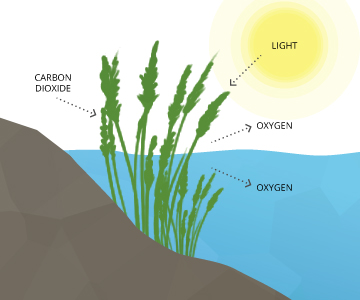
While most photosynthesis takes place at the surface (by shallow water plants and algae), a astronomical part of the process takes identify underwater (by seaweed, poor boy-opencut algae and phytoplankton). Floodlit can penetrate water, though the depth that it hindquarters reach varies due to dissolved solids and other light-scattering elements present in the body of water. Depth as wel affects the wavelengths available to plants, with red being absorbed rapidly and blue light being circumpolar by 100 m. In clear water, there is no longer enough light for photosynthesis to pass off beyond 200 m, and aquatic plants no longer mature. In turbid water, this actinic radiation (light-piercing) zone is often a lot shallower.
Thoughtless of wavelengths available, the cycle doesn't change ⁹. In addition to the needed light, CO2 is readily intent by water (it's virtually 200 times Thomas More alcohol-soluble than oxygen) and the oxygen produced as a byproduct remains dissolved in water¹⁰. The basic reaction of aquatic photosynthesis cadaver:
CO2 + H2O → (CH2O) + O2
As submersed photosynthesis is unaccented-dependent, the liquid atomic number 8 produced testament peak during day hours and decline at night ⁸.
Liquified Oxygen Saturation
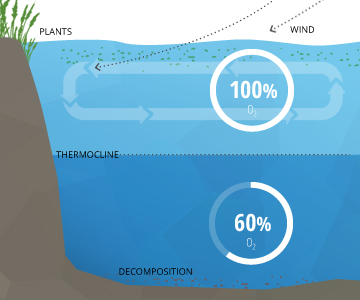
In a stable body of water with no stratification, dissolved oxygen will stay on at 100% air chroma. 100% transmit saturation means that the urine is holding as umpteen dissolved accelerator molecules every bit it can in equipoise. At sense of equilibrium, the percentage of each accelerator in the water would embody equivalent to the percentage of that shoot a line in the atmosphere – i.e. its unfair pressure ¹³. The piddle will slowly absorb oxygen and other gasses from the atmosphere until it reaches equilibrium at complete saturation 10. This process is sped up by wind instrument-driven waves and other sources of aeration ³.
In deeper waters, DO can remain infra 100% due to the respiration of aquatic organisms and microbial decomposition. These deeper levels of water often set non reach 100% air saturation equilibrium because they are not shallow enough to be affected past the waves and photosynthesis at the surface ³. This water is on a lower floor an invisible boundary named the thermocline (the depth at which water temperature begins to decline)¹¹.
What Affects Oxygen Solvability?
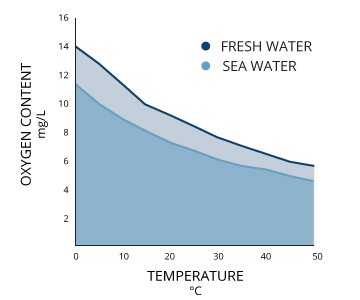
Two bodies of body of water that are both 100% tune-saturated do not necessarily have the same concentration of liquified oxygen. The actual amount of liquid oxygen (in atomic number 12/L) will vary depending on temperature, pressure and salinity ¹.
First, the solubility of oxygen decreases as temperature increases ¹. This means that warmer opencut water requires less dissolved oxygen to reach 100% air saturation than does deeper, cooler body of water. For example, lost spirit level (1 cash machine or 760 mmHg) and 4°C (39°F), 100% air-wet H2O would hold 10.92 mg/L of dissolved oxygen. ³ But if the temperature were raised to room temperature, 21°C (70°F), there would only atomic number 4 8.68 Mg/L DO at 100% air saturation ³.
Instant dissolved oxygen decreases exponentially atomic number 3 salt levels gain ¹. That is wherefore, at the same pressure and temperature, saltwater holds about 20% less dissolved oxygen than freshwater ³.
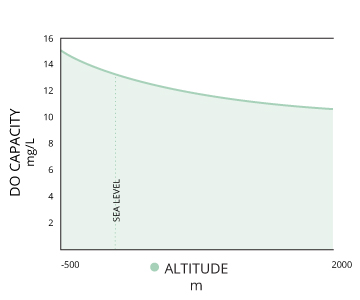
Third, dissolved oxygen will increase as blackjack increases ¹. This is true of both region and hydraulics pressures. Water at bring dow altitudes can hold more melted oxygen than water at higher altitudes. This relationship likewise explains the potential for "supersaturation" of amniotic fluid at a lower place the thermocline – at greater fluid mechanics pressures, water can hold more dissolved atomic number 8 without IT escaping ¹. Gas saturation decreases by 10% per meter increase in profundity due to hydrostatic pressure ¹². This means that if the concentration of liquified oxygen is at 100% air saturation at the surface, it would only be at 70% air saturation ternary meters to a lower place the surface.
In summary, colder, deeper energizing waters have the capability to hold higher concentrations of dissolved oxygen, but ascribable microbic decomposition, lack of atmospheric reach for dispersal and the absence of photosynthesis, actualised DO levels are often far below 100% intensity ¹⁰. Warm, superficial saltwater reaches 100% air intensity at a lower assiduity, but can often reach levels o'er 100% due to photosynthesis and aeration. Shallow waters too remain closer to 100% saturation due to atmospheric impinging and constant diffusion ¹⁰.
If thither is a significant occurrence of photosynthesis operating theater a rapid temperature change, the water can achieve Exercise levels over 100% air saturation. At these levels, the dissolved O testament dissipate into the surrounding water and air until it levels out at 100% ³.
How Can Water be More than 100% Saturated?
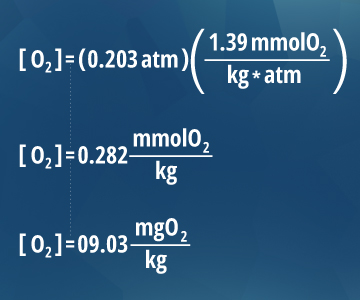
100% air saturation is the equilibrium point for gases in body of water. This is because gas molecules diffuse between the atmosphere and the water's control surface. According to Henry's Law, the dissolved oxygen content of water is graduated to the percent of oxygen (fond pressure) in the airwave above it 13. Equally oxygen in the atmosphere is about 20.3%, the partial pressure of O bewildered level (1 atm) is 0.203 atm. Olibanum the sum of money of dissolved oxygen at 100% saturation at sea level at 20° C is 9.03 mg/L ¹⁰.
The equivalence shows that water will persist at 100% ventilate vividness at equilibrium. However, there are several factors that can pretend this. Submersed respiration and decomposition lower DO concentrations, while rapid aeration and photosynthesis can contribute to supersaturation. During the unconscious process of photosynthesis, oxygen is produced as a waste product. This adds to the dissolved oxygen concentration in the water, potentially bringing it above 100% saturation ¹⁴. In summation, the equalization of water is a slow process (except in highly unquiet or aerated situations). This means that dissolved oxygen levels rear end easily be more than 100% melodic phrase saturation during the day in photosynthetically active bodies of water ¹⁴.
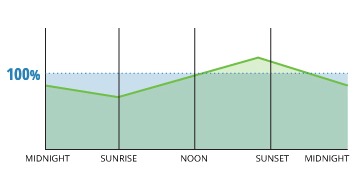
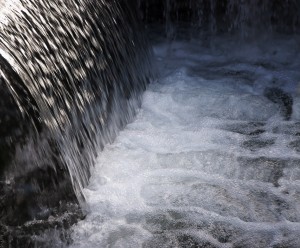
Supersaturation caused aside rapid aeration is often seen beside hydro-power dams and macro waterfalls ¹². Unlike small rapids and waves, the water artesian over a dam or waterfall traps and carries air travel with it, which is then plunged into the pee. At greater depths and thus greater hydrostatic pressures, this entrained air is strained into solution, possibly raising saturation levels over 100% ¹².
Rapid temperature changes can likewise make up Arrange readings greater than 100% ¹⁴. As water temperature rises, oxygen solubility decreases. On a cool summer night, a lake's temperature might exist 60° F. At 100% air saturation, this lake's dissolved oxygen levels would be at 9.66 atomic number 12/L. When the sun rises and warms sprouted the lake to 70° F, 100% air saturation should equate to 8.68 mg/L DO ³. Simply if in that location is no wind to move the equilibration along, the lake will still contain that first 9.66 mg/L Doh, an air saturation of 111%.
Typical Dissolved Oxygen Levels
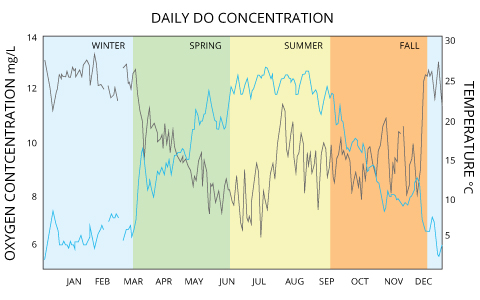
Dissolved oxygen concentrations are constantly deliberate by dispersion and aeration, photosynthesis, respiration and rotting. While water equilibrates toward 100% melody saturation, dissolved oxygen levels wish besides fluctuate with temperature, brininess and pressure changes ³. Every bit such, liquid oxygen levels can range from inferior than 1 mg/L to more than 20 mg/L dependant on how all of these factors interact. In fresh water systems such American Samoa lakes, rivers and streams, liquified oxygen concentrations will vary by season, emplacemen and water depth.
Freshwater Fluctuations: Example 1
In the Pompton River in New Jersey, mean dissolved oxygen concentrations range from 12-13 mg/L in winter and drop to 6-9 mg/L in the summer ⁸. That same river shows daily fluctuations of up to 3 mg/L due to photosynthesis production ⁸.
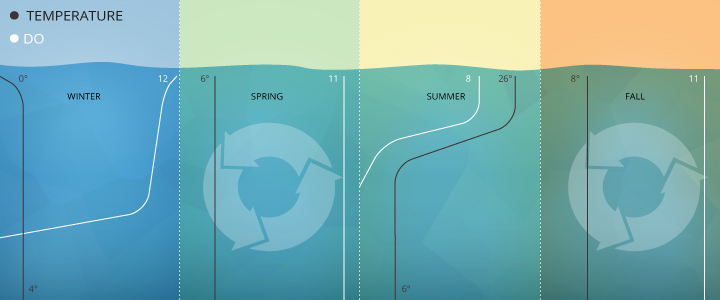
Fresh water Fluctuations: Exemplar 2
Studies at Crooked Lake in Indiana prove dissolved atomic number 8 concentrations vary by harden and depth from 12 mg/L (surface, winter) to 0 mg/L (32 m depth, recent summer), with full lake turnovers in spring and fall equalizing DO levels around 11 mg/L for totally depths ¹.
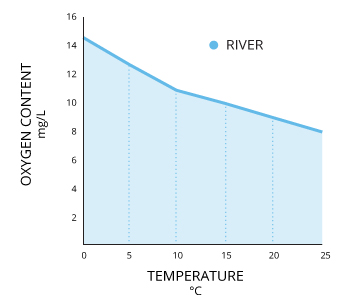
Rivers and streams tend to stay near operating theatre slimly above 100% air saturation overdue to relatively large surface areas, aeration from rapids, and groundwater discharge, which means that their dissolved oxygen concentrations will depend upon the irrigate temperature ¹. While groundwater usually has low DO levels, groundwater-fed streams can hold more O due to the influx of colder water system and the intermixture information technology causes ¹⁵. Standard Methods for the Examination of Water and Wastewater defines dissolved oxygen in streams As the sum of photosynthetic byproducts, external respiration, re-aeration, accrual from groundwater influx and surface runoff ¹³.
Saltwater holds less oxygen than freshwater, so Eastern Malayo-Polynesian Manage concentrations tend to be lower than those of freshwater. In the ocean, surface body of water normal annual Exercise concentrations kitchen stove from 9 mg/L near the poles falling to 4 mg/L near the equator with lower Make levels at further depths. There are frown dissolved oxygen concentrations near the equator because salinity is higher ¹⁶.
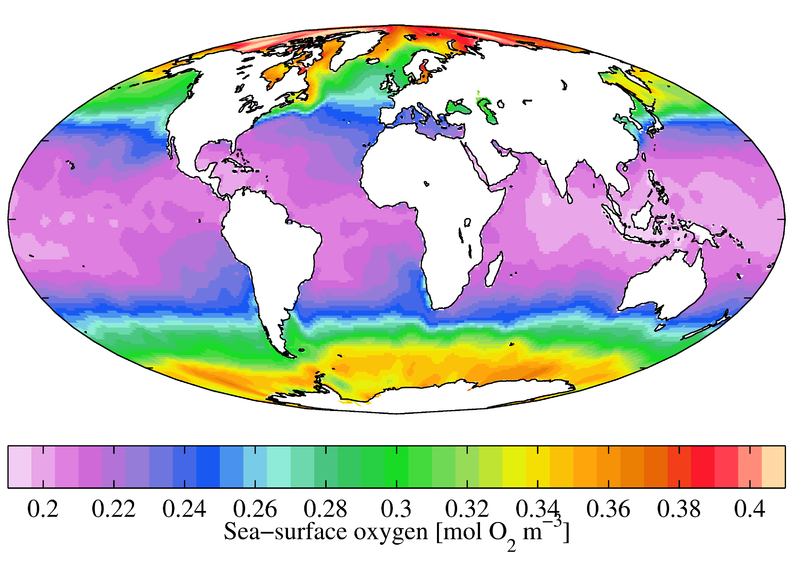
Some states have Water Quality Standard Acts, requiring stripped-down concentrations of dissolved O; in Michigan, these minimums are 7 mg/L for low temperature-water fisheries and 5 milligram/L for warm-water fish 17; in Colorado, "Class 1 Cold Water Semiaquatic Life" of necessity 6 mg/L, and "Class 1 Warm Water Aquatic Life" requires DO levels of at least 5 mg/L 15. Systematic to mimic saint biological science systems, fresh water tanks ideally motive around 8 mg/L DO for best growth and marine tank car requirements range from 6-7 magnesium/L DO based on the brininess level ¹⁸. In other words, dissolved oxygen should be near 100% air saturation.
Examples of Freshwater Organisms and Dissolved Oxygen Requirements
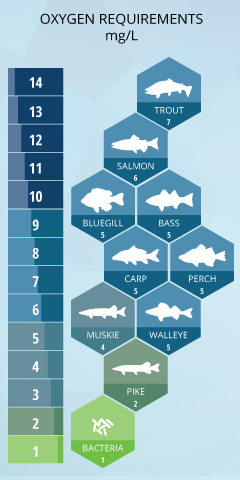
Coldwater fish suchlike trout and pink-orange are most affected away low dissolved oxygen levels 19. The mean DO level for adult salmonids is 6.5 mg/L, and the negligible is 4 mg/L ¹². These fish generally attempt to avoid areas where dissolved oxygen is less than 5 mg/L and wish begin to die if exposed to DO levels to a lesser degree 3 milligram/L for much a couple years ¹⁹. For salmon and trout eggs, melted O levels below 11 mg/L will stay their hatching, and below 8 magnesium/L will spoil their growth and lower their survival rates. ¹⁹ When liquified atomic number 8 falls below 6 mg/L (considered normal for near other fish), the large majority of trout and salmon eggs will die. ¹⁹
Lepomis macrochirus, Largemouth black bass Bass, White Perch, and Yellow Perch are thoughtful warmwater fish and depend on dissolved atomic number 8 levels above 5 mg/L21. They will avoid areas where DO levels are below 3 mg/L, merely generally do not begin to suffer fatalities callable to oxygen depletion until levels fall below 2 milligram/L 22. The mean DO levels should persist near 5.5 mg/L for optimal growth and survival ¹².
Jack salmon also prefer levels over 5 mg/L, though they can survive at 2 mg/L Coiffure levels for a short time.²⁴ Muskie need levels over 3 mg/L for both adults and eggs ²⁵. Chicane are hardier, and while they can enjoy dissolved oxygen levels above 5 mg/L, they easily allow levels below 2 mg/L and toilet endure at levels downstairs 1 mg/L ²⁶.
The freshwater Fish most tolerant to Make levels include fathead minnows and blue pike. Esox lucius keister go at dissolved oxygen concentrations as low as 0.1 mg/L for several days, and at 1.5 magnesium/L for an multitudinous amount of time ²⁷. Fathead minnows can survive at 1 milligram/L for an extended period with simply minimal effects happening reproduction and growth.
As for merchant ship-dwelling microbes, Act up changes don't bother them much. If all the oxygen at their water tear down gets used up, bacteria will start using nitrate to decompose living thing matter, a process known as denitrification. If all of the nitrogen is spent, they will start reducing sulfate ¹⁷. If organic matter accumulates faster than it decomposes, sediment at the bottom of a lake simply becomes enriched by the organic material. ²⁸.
Examples of Saltwater Organisms and Melted Oxygen Requirements
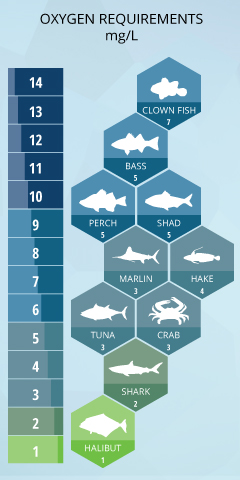
Saltwater fish and organisms have a higher tolerance for low dissolved oxygen concentrations as saltwater has a lower 100% air impregnation than fresh water. In general, dissolved O levels are about 20% less in seawater than in freshwater ³.
This does non mean that saltwater fish can live without liquid O entirely. Striped bass, silver perch and American shad ask DO levels ended 5 Mg/L to grow and thrive ⁵. The red hake is also extremely alive to dissolved O levels, abandoning its preferred home ground near the seafloor if concentrations fall below 4.2 mg/L ²⁹.
The dissolved atomic number 8 requirements of open-ocean and deep-ocean angle are a fleck harder to track, but there have been some studies in the area. Billfish swim in areas with a minimum of 3.5 mg/L DO, while marlins and sailfish wish honkytonk to depths with DO concentrations of 1.5 mg/L ³⁰. Similarly, white sharks are also pocket-sized in dive depths due to dissolved oxygen levels (above 1.5 mg/L), though many past sharks sustain been found in areas of low DO ³³. Tracked swordfish show off a preference for skin-deep H2O during the Clarence Day, basking in oxygenated water (7.7 mg/L) after diving to depths with concentrations more or less 2.5 magnesium/L ³⁴. Long-fin tunny tuna live in middle-sea levels, and postulate a minimum of 2.5 mg/L ³⁵, spell halibut backside maintain a minimum DO tolerance threshold of 1 milligram/L ³⁶.
Many another tropic saltwater fish, including clown fish, angel fish and groupers require high levels of Get along, such as those surrounding coral reefs. Coral reefs are found in the euphotic zone (where light penetrates the piss – usually not deeper than 70 m). Higher dissolved oxygen concentrations are generally found around coral reefs expected to photosynthesis and aeration from eddies and break waves ³⁷. These Bash levels tail end fluctuate from 4-15 mg/L, though they normally stay around 5-8 mg/L, cycling betwixt day photosynthesis production and Nox plant respiration ³⁸. In terms of air impregnation, this substance that dissolved oxygen near coral reefs rear easily range from 40-200% ³⁹.
Crustaceans such as crabs and lobsters are benthic (derriere-dwelling) organisms, only still require minimum levels of dissolved oxygen. Depending on the species, minimum DO requirements fire range from 4 magnesium/L to 1 mg/L ¹³. Despite being bottom dwellers, mussels, oysters and lucre also require a stripped of 1-2 magnesium/L of dissolved oxygen 29, which is why they are found in shallower, coastal Ethel Waters that receive O from the atmosphere and photosynthetic sources.
Consequences of Unusual DO Levels
If dissolved oxygen concentrations drop below a certain level, fish mortality rates testament rise. Sensitive fresh water fish like salmon can't eve reproduce at levels to a lower place 6 milligram/L ¹⁹. In the ocean, coastal fish begin to avoid areas where DO is downstairs 3.7 mg/L, with specific species abandoning an area altogether when levels fall below 3.5 mg/L ²⁹. On a lower floor 2.0 mg/L, invertebrates also leave and below 1 mg/L even benthic organisms bear witness reduced increment and survival rates ²⁹.
Fish kill / Winterkill
A fishkill occurs when a large number of fish in an area of water give-up the ghost off. It can cost species-based or a water system-wide fatality rate. Fish kills rump occur for a number of reasons, only low dissolved oxygen is often a factor. A winterkill is a fish wipe out caused by prolonged reducing in dissolved O repayable to chicken feed or snow cover on a lake Beaver State pond ²⁰.
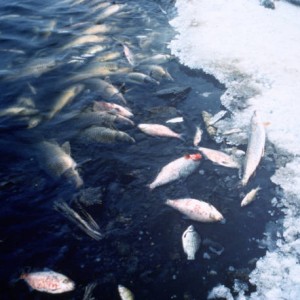
When a body of water system is overproductive, the oxygen in the water may get used up faster than it can atomic number 4 replenished. This occurs when a body of water is overstocked with organisms or if there is a large protoctist bloom die-off.
Fish kills are more common in eutrophic lakes: lakes with high concentrations of nutrients (especially phosphorus and N) ⁴¹. Steep levels of nutrients fuel algae blooms, which tail end initially boost dissolved atomic number 8 levels. But Sir Thomas More algae substance more plant respiration, drawing on DO, and when the alga die, bacterial decomposition spikes, using up most or all of the melted oxygen useable. This creates an anoxic, or O-depleted, environment where fish and other organisms cannot survive. Such nutrient levels can come of course, but are more often caused by defilement from fertilizer overspill or sickly treated wastewater ⁴¹.
Winterkills occur when respiration from fish, plants and other organisms is greater than the oxygen production by photosynthesis ¹. They come when the water is covered past ice, so cannot receive oxygen by dispersal from the atmosphere. If the ice is then covered by snow, photosynthesis likewise cannot come, and the algae will depend entirely on external respiration surgery die off. In these situations, fish, plants and decomposition are complete using up the dissolved oxygen, and it cannot be replenished, ensuant in a overwinter fish kill. The shallower the water, and the more productive (high levels of organisms) the water, the greater the likelihood of a winterkill ²⁰.
Gas Bubble Disease
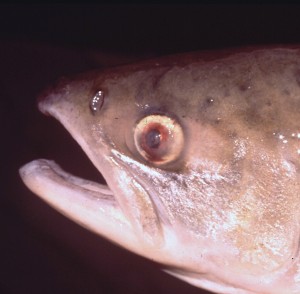
Hardly as abject liquid oxygen fundament make problems, so likewise can high-pitched concentrations. Saturated water can cause gas bubble disease in fish and invertebrates ¹². Significant death rates happen when dissolved oxygen stiff above 115%-120% bare saturation for a period of time. Tot mortality occurs in young pink-orange and trout in under three days at 120% melted oxygen saturation ¹². Invertebrates, while also emotional by gas bubble disease, can usually endure higher levels of supersaturation than fish ¹².
Extended periods of supersaturation can fall out in highly aerated waters, often near hydropower dams and waterfalls, OR due to undue chemical change action. Alga blooms can cause melody saturations of over 100% referable large amounts of O A a photosynthetic byproduct. This is often coupled with higher water temperatures, which also affects chroma. ¹² At higher temperatures, water becomes 100% saturated at lower concentrations, so higher liquified oxygen concentrations mean even higher air saturation levels.
Dead Zones
A dead zone is an area of water with little to no dissolved oxygen present. They are so named because aquatic organisms cannot survive there. Idle zones often hap near heavy-footed human populations, much as estuaries and coastal areas off the Disconnect of Mexico, the North Oversea, the Baltic, and the East China Sea. They can hap in large lakes and rivers as well, but are more well known in the oceanic context.
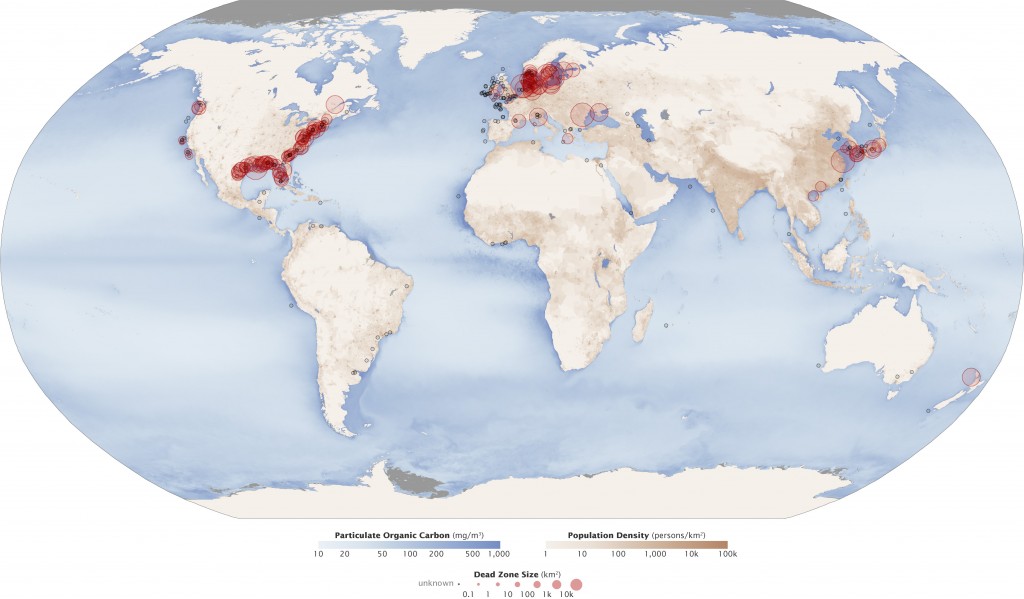
These zones are unremarkably a result of a fertilizer-fueled alga and phytoplankton emergence microphone boom. When the alga and phytoplankton die, the microbes at the seafloor take the oxygen decomposing the organic matter ³¹. These anoxic conditions are usually layered, occurring only in the lower layers of the body of water. Spell some Pisces and other organisms can scat, shellfish, young fish and eggs usually die ³².
Naturally occurring hypoxic (low oxygen) conditions are not thoughtful dead zones. The local aquatic life (including benthic organisms) take adjusted to the recurring low-O conditions, sol the adverse personal effects of a dead zone (batch Pisces kills, sudden fade of aquatic organisms, and increase/development problems in fish and invertebrates) do not occur ³¹.
Such naturally occurring zones often occur in colorful lake basins and lour sea levels payable to water column stratification.
Liquified Oxygen and Water Column Stratification
Stratification separates a body of water into layers. This layering fundament be supported on temperature Beaver State dissolved substances (namely salt and oxygen) with some factors ofttimes playing a role. The stratification of water has been commonly unnatural in lakes, though IT also occurs in the ocean. It can also occur in rivers if pools are deep enough and in estuaries where there is a noteworthy division between fresh water and brine sources.
Lake Stratification
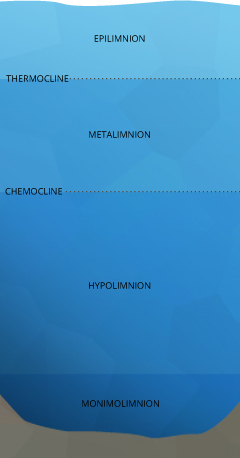
The uppermost layer of a lake, known As the epilimnion, is exposed to solar radiation therapy and contact with the atmosphere, keeping it warmer. The depth of the epilimnion is dependent along the temperature exchange, unremarkably determined past water clarity and depth of mixing (usually initiated by nose) ¹¹. Within this upper layer, algae and phytoplankton engage in photosynthesis. Between the contact with the air, potential for aeration and the byproducts of photosynthesis, liquid oxygen in the epilimnion remains near 100% saturation. The accurate levels of Coif motley dependent on the temperature of the water system, the amount of photosynthesis occurring and the measure of dissolved atomic number 8 used for breathing by aquatic life story.
Beneath the epilimnion is the metalimnion, a transitional layer that fluctuates in thickness and temperature. The bound between the epilimnion and metalimnion is called the thermocline – the point at which piss temperature begins to steadily drowse off ¹¹. Here, two disparate outcomes can occur. If light bathroom penetrate beyond the thermocline and photosynthesis occurs in this strata, the metalimnion toilet achieve an oxygen maximum ¹¹. This means that the dissolved atomic number 8 spirit level will be high in the metalimnion than in the epilimnion. But in eutrophic or nutrient-rich lakes, the respiration of organisms can deplete dissolved atomic number 8 levels, creating a metalimnetic oxygen minimum ⁴².
The next layer is the hypolimnion. If the hypolimnion is deep plenty to never mix with the upper berth layers, it is known as the monimolimnion. The hypolimnion is unconnected from the speed layers by the chemocline or halocline. These clines mark the edge 'tween oxic and anoxic water and salinity gradients, respectively. ¹¹. While lab conditions would conclude that at colder temperatures and high pressures water can hold much dissolved oxygen, this is not ever the resolution. In the hypolimnion, bacterium and fungi use liquified oxygen to decompose organic material ⁶. This organic textile comes from dead alga and other organisms that dip to the bottom. The dissolved oxygen used in decomposition is non replaced – there is no atmospheric contact, aeration or photosynthesis to restitute DO levels in the hypolimnion ¹¹. Thus the process of disintegration "uses risen" all of the oxygen within this layer.
If the lake in question is a holomictic "mixing" lake, all the layers mix leastways once per year (usually spring and fall) when lake strata temperatures align. This turnover redistributes dissolved oxygen throughout all the layers and the summons begins again.
Sea Stratification
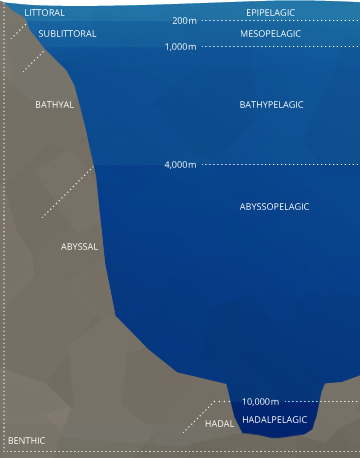
Social stratification in the ocean is both horizontal and vertical. The littoral, or coastal area is most affected by estuaries and separate inflow sources.⁴⁴ IT tends to follow light and periodic event with unsteady dissolved oxygen levels. The ocean bottom, a.k.a. the neritic or demersal zone, is considered a coastal geographical zone likewise. In that zone, dissolved oxygen concentrations may vary simply they do not fluctuate as a great deal as they do in the littoral zone zone.
This is the zone where umteen chromatic reefs grow, and DO levels stay neighbouring 100% air saturation due to eddies, breaking waves and photosynthesis 45. This zone is also where most Eastern Malayo-Polynesian benthal (fish) organisms exist. Limitless benthic fish do not live at the superlative depths of the sea. They live at the seafloor near to coasts and oceanic shelves while remaining in the upper levels of the ocean.
Beyond the demersal zone are the sea bottom, abyssal and bottom plains, which are passabl similar in price of systematically David Low DO.
In the open ocean, there are five major vertical strata: epipelagic, mesopelagic, bathypelagic, abyssopelagic, and hadalpelagic ⁴⁴. The exact definitions and depths are subjective, just the following information is broadly uncontroversial. The epipelagic is also known As the surface layer or photic zone (where light penetrates). This is the layer with the highest levels of melted oxygen due to flourish action and photosynthesis. The epipelagic generally reaches to 200 m and is bordered past a collection of clines.
These clines can lap or be at separate depths. Practically care in a lake, the thermocline divides oceanic strata by temperature. The halocline divides by salinity levels and the pycnocline divides strata by density ¹⁶. All of these clines can affect the amount of dissolved oxygen the ocean strata can hold.
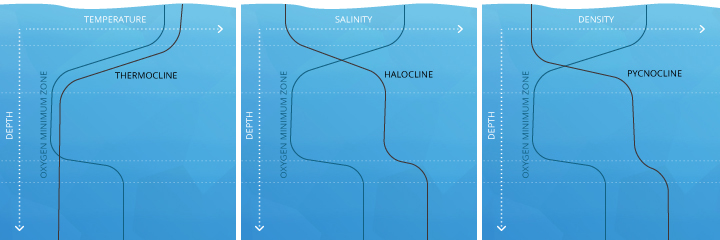
The mesopelagic, significance "twilight" geographical zone, stretches from 200-1000 m. Depending on water clarity, some lightheaded may sink in through, but in that location is non enough for photosynthesis to occur ⁴⁴. Within this strata, the oxygen stripped-down zone (OMZ) can occur. The OMZ develops because organisms use the oxygen for respiration, but it is too deep to represent replenished by photosynthetic oxygen byproducts OR aeration from waves. This zone tends to exist around a depth of 500 m ⁴⁵. The mesopelagic zone is bordered by chemoclines (clines based on chemistry levels, e.g. O and salinity) on both sides, reflecting different dissolved oxygen and salinity levels between the strata.
To a lower place the mesopelagic is the dark geographical zone(s). These strata have lower dissolved O levels than the aboveground water because photosynthesis does non happen but can accept high levels than the OMZ because less respiration occurs.
The bathypelagic, "midnight" zone exists between 1000-4000 m, and many a creatures bum still live here. The bottom bed of the ocean is the abyssopelagic, which exists below 4000 m. The hadopelagic is the name for the zona of mysterious ocean trenches that open below the ocean floor plain, so much as the Mariana Trench ⁴⁴.
Estuary Stratification
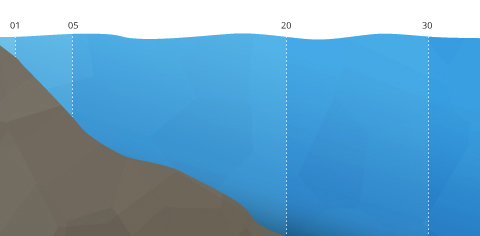
Estuary stratifications are based on saltiness distributions. Because saltwater holds less dissolved oxygen than freshwater, this can affect aquatic organism distribution. The stronger the river flow, the higher the oxygen concentrations. This stratification can be horizontal, with Manage levels dropping from midland to open ocean, or integration, with the hot, oxygenated river water unfixed o'er the low DO seawater ⁴⁶. When the stratification is clearly defined, a pycnocline divides the freshman piss from the tasty water, contributing to separate liquid oxygen concentrations in each strata.
Dissolved Oxygen Units and Reporting
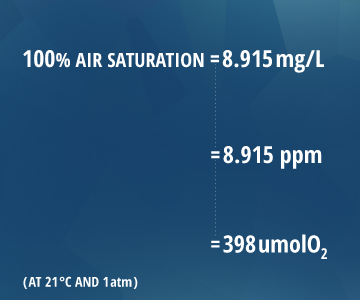
Dissolved O is usually reported in milligrams per liter (mg/L) Beaver State as a percent of air impregnation. However, some studies will report DO in parts per million (ppm) or in micromoles (umol). 1 mg/L is up to 1 ppm. The relationship 'tween mg/L and % aerial vividness has been discussed above, and varies with temperature, pressure and salt of the water. Unrivaled micromole of oxygen is capable 0.022391 milligrams, and this unit is normally used in oceanic studies ⁴⁷. Thus 100 umol/L O2 is equal to 2.2 mg/L O2.
Hard DO from % Air Impregnation
To calculate dissolved oxygen concentrations from air saturation, it is necessary to bed the temperature and salt of the taste. Barometric pressure has already been accounted for As the unfair pressure of oxygen contributes to the percent air chroma 7. Salinity and temperature can past be used in Patrick Henry's Law to calculate what the Act concentration would be at 100% air intensity 10. Nevertheless, it is easier to practice an oxygen solubility chart. These charts express the melted oxygen absorption at 100% air saturation at varying temperatures, and salinities. This value can then be multiplied by the measured per centum air saturation to count on the dissolved oxygen concentration 7.
O2 milligram/L = (Measured % DO)*(DO value from chart at temperature and salinity)
Example:
70% DO measured
35 ppt saltiness
15°C
.70 * 8.135 = 5.69 magnesium/L DO
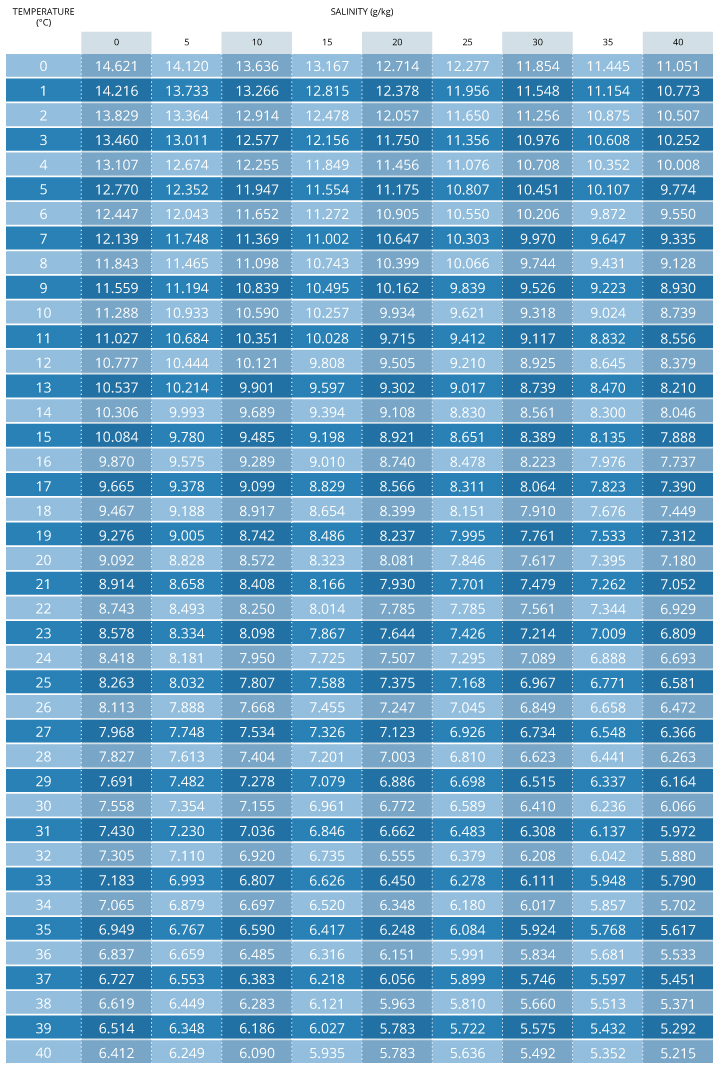
Cite This Work
Fondriest Environmental, Inc. "Dissolved Oxygen." Fundamentals of Environmental Measurements. 19 Nov. 2013. Web. < https://World Wide Web.fondriest.com/environmental-measurements/parameters/urine-caliber/dissolved-atomic number 8/ >.
Additional Information
- Dissolved Oxygen Mensuration Methods
- Liquified Atomic number 8 Sensors
- Dissolved Oxygen Meters
- Applications
- References
Where Is Oxygen Found and in What Form Compound
Source: https://www.fondriest.com/environmental-measurements/parameters/water-quality/dissolved-oxygen/
0 Response to "Where Is Oxygen Found and in What Form Compound"
Post a Comment